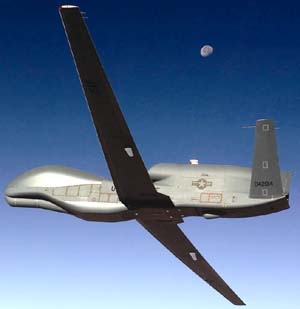Northrop Grumman this week began live calibration testing of a new detect, sense and avoid (DSA) sensor fusion prototype that could help the US military in its quest to begin more readily flying high altitude long endurance (HALE) unmanned aerial vehicles (UAVs) in US civil airspace. The company is using a suite of four sensors, including radar, for DSA testing on cooperative and non-cooperative intruders.
Equipping UAV systems with the means to automatically see and avoid traffic has long been a key hurdle that operators must overcome in an effort to gain “file and fly” approval from the US Federal Aviation Administration (FAA) for flights in civil airspace.
Without vetted technologies that offer an “equivalent level of safety” to manned aircraft in terms of DSA, the FAA currently maintains safety standards by restricting UAV operations using limited duration certificates of authorization obtained by operators. The practice is widely viewed as overly time consuming and restrictive however.
The thrust of Northrop Grumman’s efforts is to investigate and demonstrate a variety of sensors, fusion algorithms and avoidance techniques that could be carried by HALE platforms like the Predator and Global Hawk to achieve an “equivalent level of safety” to that of manned aircraft. The work is being funded by the US Air Force Research Lab.
“It’s not inconceivable that DSA technology will be ready for use within a matter of years,” said Alfredo Ramirez, chief architect for Northrop Grumman’s High Altitude Long Endurance (HALE) Systems Enterprise, speaking at a US National Transportation Safety Board UAV safety forum in Washington, DC, 30 April. “The real hard part is the quantification of ‘equivalent level of safety’. How does that translate into a specification? There are many assumptions and decisions that have to be embedded,” Ramirez says.

The approach Northrop Grumman is currently investigating uses a fusion algorithm that detects and tracks cooperative and non-cooperative targets in a 30-degree vertical by 135-degree horizontal field-of-view in front of the aircraft using a transponder-based traffic alert and collision avoidance system, an automatic dependent surveillance-broadcast (ADS-B) unit, an electro-optical (EO) sensor and purpose-built radar. The suite is carried by a surrogate aircraft, in this case a specially modified Calspan Learjet, flying in a test area over upper New York State. The FAA has provided a King Air aircraft with ADS-B equipment to help calibrate the equipment.
If calibration tests this week go as planned, Northrop Grumman says it will stress the system with live multiple intruder aircraft during three rounds of testing this summer. The software is designed to handle a maximum of 30 simultaneous intruder aircraft. Tests with TCAS and EO sensors in 2006 and 2007 successfully demonstrated DSA using the Calspan HALE surrogate and a single intruder.
Source: Flight International























